Michigan, bordering four of the five Great Lakes, enjoys a humid continental climate with warm, humid summers and cold winters. These diverse weather conditions, coupled with ample rainfall, allow for a diverse landscape, including open fields, dense forests, and common weeds.

However, apart from the common culprits that thrive in the nutrient-rich soils, increasing temperatures in Michigan have also encouraged more weeds to thrive across the Midwestern State.
In this article, we’ll look at the most prevalent weeds in Michigan, how to identify them, and the best strategies to effectively remove them.
1. Common Chickweed (Stellaria media)

- Local Name: Common Chickweed
- Family: Caryophyllaceae
- Annual or Perennial: Annual
Common Chickweed is a small, low-growing winter annual that thrives in shady and moist landscape areas. It has teardrop-shaped light green leaves and small, star-like flowers.
The broadleaf forms mounded patches about 3-7 inches tall that can smother seedlings of desirable plants and turf.
The best removal methods include pulling, tillage best conducted in the fall, mulching in garden beds, crop rotation in wheat fields, or herbicides containing 2,4-D, dicamba, triclopyr, and mecocrop.
2. Broadleaf Plantain (Plantago major)

- Local Name: Broadleaf plantain
- Family: Plantaginaceae
- Annual or Perennial: Perennial
Broadleaf Plantain is one of the most common weeds, only second to dandelion in Michigan. The broadleaf weed can adapt to a variety of soils, allowing it to grow in diverse areas, including manicured lawns, roadsides, and disturbed sites.
You can easily identify it by its smooth, broad to narrow oval leaves that emerge from a rosette attached to a thick taproot and leafless slender spikes with tiny white flowers at the end of the spikes.
Remove the weeds by pulling or digging, and ensure you remove the taproot. This is easier when the soil is moist, for instance, after irrigation or rain. Mulching and herbicides like glyphosate can also provide effective control against P. major.
3. Smooth Crabgrass (Digitaria ischaemum)
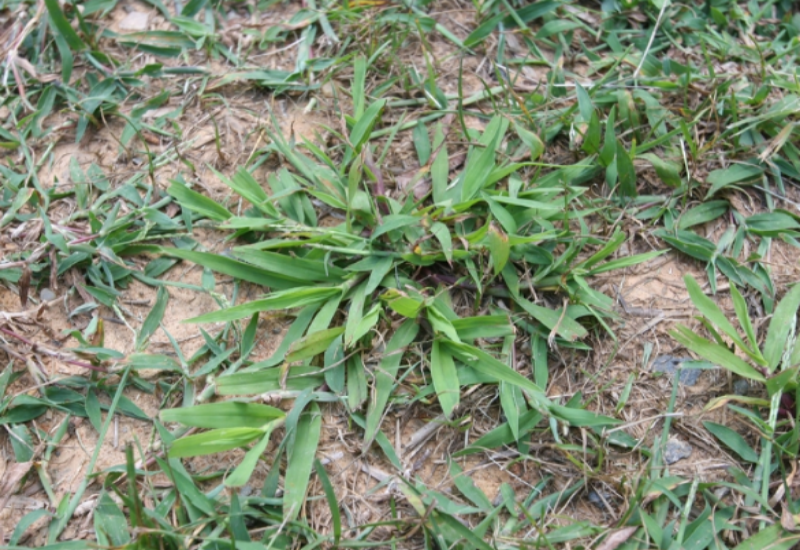
- Local Name: Smooth Crabgrass or Small Crabgrass
- Family: Poaceae
- Annual or Perennial: Annual
Smooth Crabgrass is a warm-season grass weed that germinates in spring and grows throughout summer. It thrives in open areas, especially in vegetable gardens, lawns, roadsides, and sidewalks.
You can differentiate it from other Digitaria species by its smooth leaves and stems with occasional hairs.
Since it’s a ground-hugging grass, it can get difficult to control if allowed to establish. Pull out the small mounds before they develop secondary fibrous roots. You can also consider a crabgrass preventer herbicide application for your lawn in to prevent germination in spring.
4. Dandelion (Taraxacum officinale)
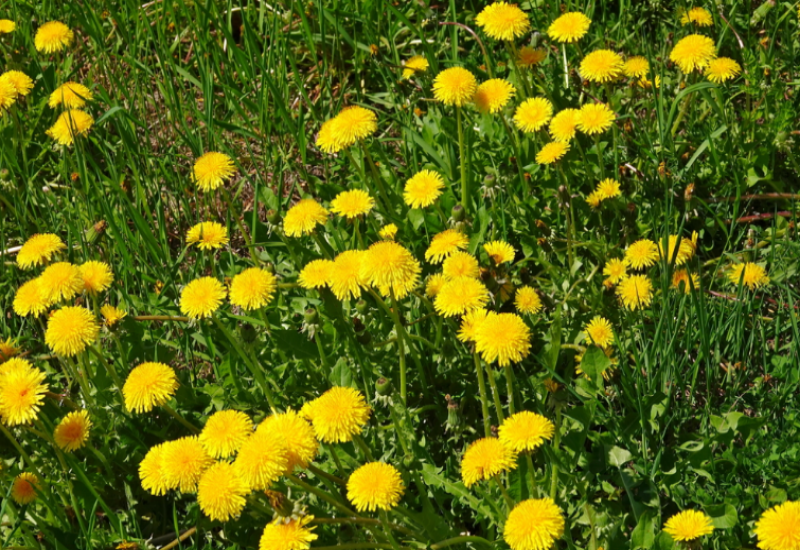
- Local Name: Dandelion
- Family: Asteraceae
- Annual or Perennial: Perennial
No lawn or garden is immune to the most common weed in Michigan, the Dandelion. While it has stunning, bright yellow flowers that later become fluffy seed heads, it can easily take over your landscape.
If left unchecked, the perennial weed can spread many seeds (15,000 per solitary dandelion) over large areas. Additionally, the taproot persists through winter to allow new sproutings in the next spring.
Pull out these weeds by hand or use dandelion removal tools to remove the entire taproot. In gardens, planting early can reduce space and competitiveness. Fall applications of herbicides like 2,4-D, glyphosate, and triclopyr can control larger infestations.
5. White Clover (Trifolium repens)
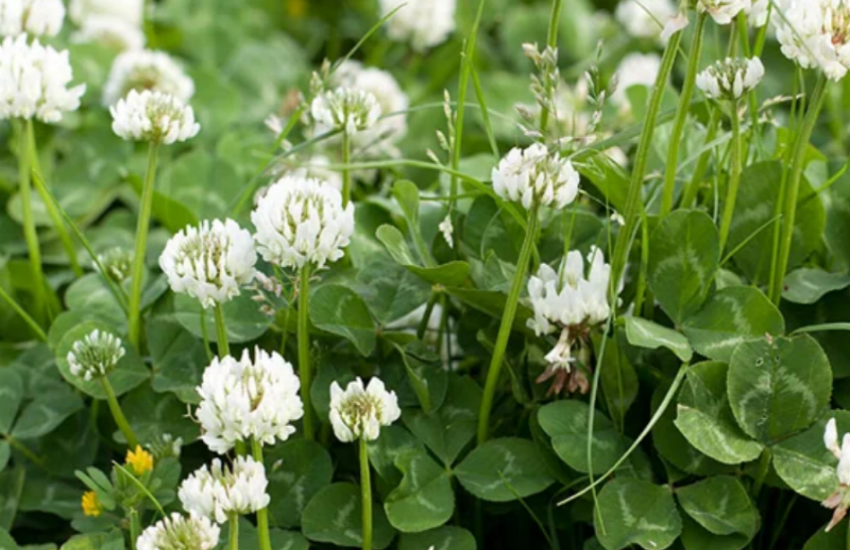
- Local Name: White Clover
- Family: Fabaceae
- Annual or Perennial: Perennial
White clover is a creeping plant native to Europe and Asia that is popularly cultivated as a forage crop. In Michigan, clover is referred to more as a weed and can be found in open woods, dry meadows, pastures, and closer to home, in gardens and lawns with nutrient deficiencies.
Clover can be easily identified by its trifoliate leaves and white to pink flowers. It is a nitrogen-fixing plant so, you may allow it to grow to benefit your soil and vegetation.
However, if you can’t stand the weed in your landscape, pull them out when young and maintain a healthy lawn that can outcompete the weed.
6. Quackgrass (Elymus repens)

- Local Name: Quackgrass, Quitch Grass, Knot Grass, Wheat Grass, or Couch Grass
- Family: Poaceae
- Annual or Perennial: Perennial
Quackgrass is an aggressive weed commonly found in gardens, lawns, and crop fields. It is easily distinguished from other grasses by its evergreen, linear, blue-green color and wheat-shaped spikelets.
The highly competitive grass spreads by seeds and rhizomes and can lead to loss of aesthetic appeal in manicured spaces and high yield losses in cropping systems.
Well-planned and repeated cultivation can help eradicate the grass. Ensure to clean the equipment and dispose of all the rhizome fragments to prevent reinfestation.
Crop rotation of plants that accrue high biomass or competitive species like Hairy Vetch in crop fields can reduce the grass infestation.
Nicosulfuron in farms and postemergence herbicides like glyphosate are also effective in quackgrass control.
7. Canada Thistle (Cirsium arvense)
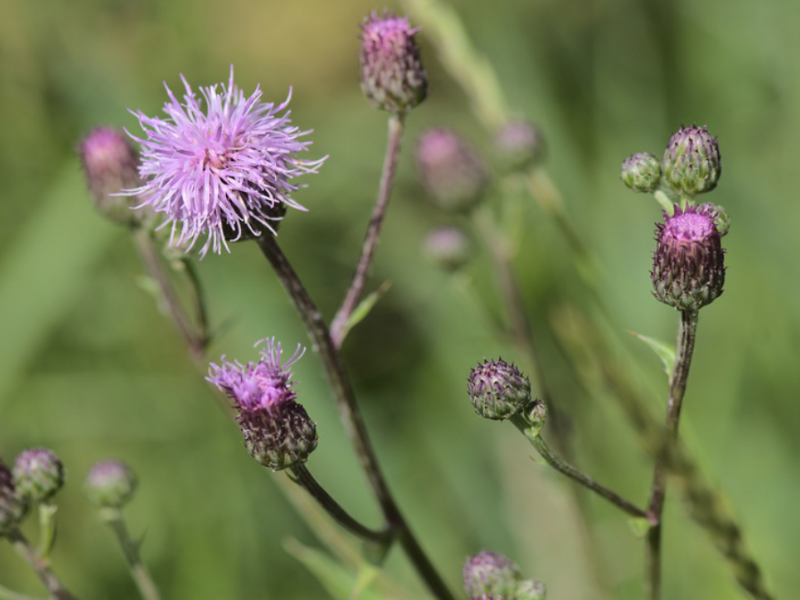
- Local Name: Canada Thistle
- Family: Asteraceae
- Annual or Perennial: Perennial
Canada Thistle is a perennial spring weed that grows in thick patches about 3-5 feet tall. It produces lance-shaped leaves with spiny margins and fuzzy undersides and pink to white flowers surrounded by flat bracts.
It spreads aggressively by roots, expanding 6-10 feet wide in a single growing season. Repeat hand-pulling of the rosette leaves to eradicate the plants. For blooming plants, cut the flowers and the seedhead and dispose of them properly.
Herbicides like glyphosate, dicamba, and 2,4-D applied between the bud and flower stages can control larger and more established infestations.
8. Henbit (Lamium amplexicaule)

- Local Name: Henbit
- Family: Lamiceae
- Annual or Perennial: Annual
Henbit is a winter annual that grows about 5 inches tall. In Michigan, it emerges in the late fall and can be easily identified by its green to purple square stems and showy purple to pink flowers.
The Eurasian native is considered among the most troublesome weeds in gardens, lawns, pastures, and in cropping systems like grain and wheat fields.
Late fall and early spring tillage can control henbit seedlings. Crop rotation and optimal planting of grains can limit the spread. Herbicides recommended for henbit control should be applied in the fall. They include glyphosate and paraquat.
9. Bull Thistle (Cirsium vulgare)

- Local Name: Bull Thistle
- Family: Asteraceae
- Annual or Perennial: Biennial
Bull is a biennial broadleaf weed that thrives in various habitats in Michigan, including roadsides, meadows, fields, ditches, riparian areas, and other disturbed sites.
You can identify the weed by its spiny stems and leaves, and pink to purple flowers present on a gumdrop-shaped flower head with numerous surrounding spines.
To prevent the rapid spread of the noxious weed, pull out the small plants and retrieve the taproot. Make sure to wear protective clothing as you handle the weeds.
For larger infestations, targeted mowing can help reduce seeding and hence control the populations. Alternatively, apply glyphosate or triclopyr to eliminate Bull Thistle.
Since C. vulgare is a prolific seed producer, eradicating it requires several seasons of consistent management and monitoring, so exercise patience as you tackle the weed.
10. Giant Foxtail (Setaria faberi)
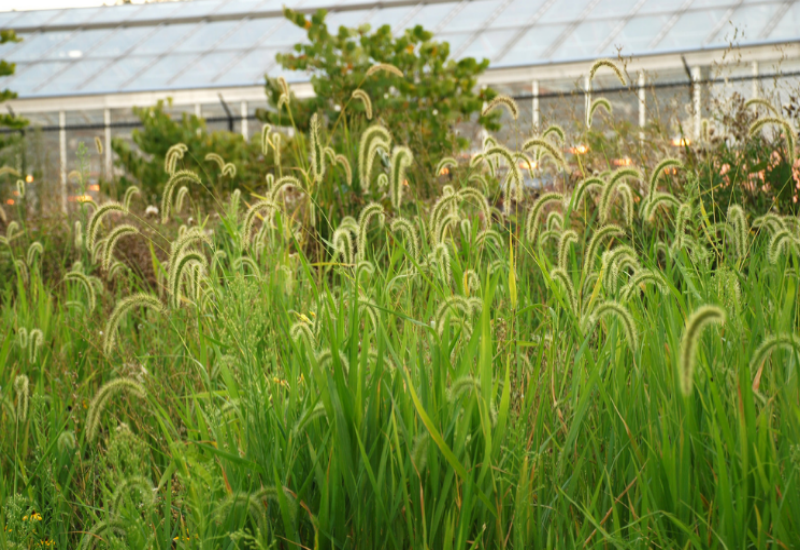
- Local Name: Giant Foxtail or Nodding Foxtail
- Family: Poaceae
- Annual or Perennial: Annual
Giant Foxtail is a summer annual that emerges in spring and grows to about 3-7 feet tall. It is native to Eastern Asia and was first introduced in New York City and then spread to other states, including Michigan.
This foxtail has 12-inch-long leaves with hairs on the upper surface and folded in a bud. It also has erect, clump-forming stems and cylindrical panicles of green to purple bristles that droop at maturity and resemble a fox’s tail.
While unassuming at first, this troublesome weed can outcompete other desirable plants and turf in gardens, lawns, and many agronomic cropping systems.
Cover cropping and crop rotation can reduce the weed density and spread. Apply preemergence and postemergence herbicides such as atrazine, fenoxaprop, and glyphosate, depending on the area of infestation, to control large infestations.

Lead Editor for Insight Weeds.